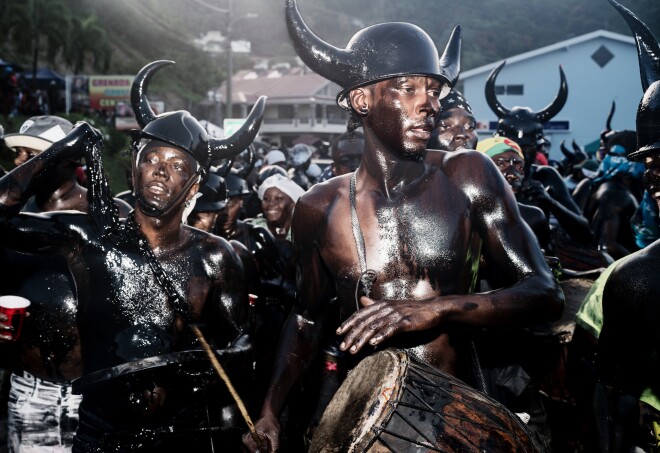Overview
When’s the best time to go to St. Vincent and the Grenadines?
Though the temperature is steady, the humidity fluctuates throughout the year—the wet season runs from June through October, while the dry season goes from mid-November through April or May. That being said, St. Vincent and especially the Grenadines often avoid severe autumn hurricanes. As in the rest of the Caribbean, rates at luxury resorts are highest from December 15 to April 15. However, prices at smaller hotels, inns, and guesthouses usually remain the same year-round. Those looking to plan their visit around special events should consider the Mustique Blues Festival in January, the Bequia Easter Regatta in the spring, or Vincy Mas (St. Vincent’s carnival) in late June and July.
How to get around St. Vincent and the Grenadines
Several airlines offer non-stop flights into St. Vincent’s Argyle International Airport, including Caribbean Airlines (from New York’s JFK), American Airlines (from Miami starting December 15, 2018), and LIAT and SVGAir (from Barbados and St. Lucia). SVGAir also flies daily from St. Vincent to Bequia, Mustique, Canouan, and Union Island.
Ferries travel frequently between St. Vincent and Bequia, with some—including the Jaden Sun fast ferry—continuing on to Canouan, Mayreau, and Union. Additionally, visitors can rent a car on St. Vincent and Bequia, reserve a “mule” (beach buggy) on Mustique, or take a taxi on Canouan and Union Island. The other islands are walkable.
Food and drink to try in St. Vincent and the Grenadines
Dining in St. Vincent and the Grenadines is almost always a casual affair, the exception being a handful of high-end resort restaurants, where women don sundresses and men are required to wear long pants and collared shirts. While some large resorts also offer sophisticated international cuisine, the majority of restaurants here focus on fresh-caught fish, lobster in season, local vegetables, and fresh fruit. At small inns and local restaurants, you can also find barbecued or baked chicken, grilled fish, mutton or fish stew, and curried goat, typically accompanied by rice and peas, root vegetables, plantains, green salad, and “bakes” (biscuits). For a snack during the day, pick up a roti (a meat- or vegetable-filled turnover) or some fish and chips.
The official national dish is fried jackfish and roasted breadfruit. A common substitute for potatoes, the ubiquitous breadfruit is also often served mashed, boiled, or even in a salad. Sunset is the local rum brand and Hairoun is the local beer.
Culture in St. Vincent and the Grenadines
St. Vincent has a turbulent history. Carib Indians once controlled the rugged island, thwarting French and English colonization until the 18th century. (On a visit to Fort Charlotte, north of Kingstown, you’ll notice cannons aimed inward, where most Carib attacks originated.) The English ultimately prevailed, taking over the island and forcing the natives into slavery. On the eastern coast near Georgetown, you can still see Black Point Tunnel, where slaves hand-carved a shorter route between the sugar works and the sea.
St. Vincent and the Grenadines earned its independence in 1979. Today, it’s a peaceful nation that enjoys a good party, especially in late June and July when locals come together to celebrate Vincy Mas (St. Vincent’s carnival) with costumes, parades, music, food, and the annual naming of a king and queen.
Can’t miss things to do in St. Vincent and the Grenadines
On St. Vincent, you’ll learn a lot about the nation’s history and people by visiting Fort Charlotte, touring the Botanic Garden, and simply walking around Kingstown. Adventurous visitors can attempt the climb up La Soufrière (the volcano that covers about a third of the island), but everyone should get out on the water and visit the dazzling Grenadines. Each island has a different appeal, but all are ringed with powder-soft, white-sand beaches and an aquamarine sea with gentle surf. Sailing on your own or a chartered sailboat is ideal, but even a ferry ride is a delightful way to spend a day. Highlights include Tobago Cays, Saltwhistle Bay Beach on Mayreau, Basil’s Beach Bar on Mustique, and Port Elizabeth on Bequia.
Local travel tips for St. Vincent and the Grenadines
A Caribbean vacation doesn’t have to break the bank. Of course, there are high-end resorts scattered throughout the Grenadines—including two on privately owned islands and another geared toward the rich, famous, or royal—but those in the know choose from the many family-run hotels, inns, and guesthouses for a truly Caribbean experience. You’ll find the best ones—near a beautiful beach or colorful village—on St. Vincent, Bequia, Mayreau, and Union Island. Also, you don’t need your own yacht to sail around the Grenadines. Ferries are fun, frequent, and inexpensive.
Local Resources
Practical Information
To enter St. Vincent and the Grenadines, U.S., Canadian, and British citizens must present a valid passport and a return or ongoing ticket. The official language is English, and the currency is the Eastern Caribbean dollar (with a fixed exchange rate of EC$2.67 per US$1), although hotels, restaurants, and most shops accept U.S. dollars and major credit cards. The electric current is 220–240 volts, but large resorts and even some small hotels are also equipped with 110-volt outlets (U.S. standard).
Guide Editor
A freelance travel writer based in Connecticut, Jane Zarem has been traveling to—and writing about—St. Vincent and the Grenadines since 1995. She authored Fodor’s In Focus: Barbados & St. Lucia (now in its fifth edition) and currently covers several islands for Fodor’s Caribbean. Her travel articles, covering much of the globe, have appeared in various publications over the years, most recently in Rand McNally’s Getaway magazine and its Road Atlas. She is a member of the New York Travel Writers’ Association.








